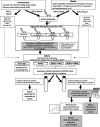Improvements to the Success of Outbreak Investigations of Legionnaires' Disease: 40 Years of Testing and Investigation in New York State
- PMID: 34085864
- PMCID: PMC8315175
- DOI: 10.1128/AEM.00580-21
Improvements to the Success of Outbreak Investigations of Legionnaires' Disease: 40 Years of Testing and Investigation in New York State
Abstract
Since 1978, the New York State Department of Health's public health laboratory, Wadsworth Center (WC), in collaboration with epidemiology and environmental partners, has been committed to providing comprehensive public health testing for Legionella in New York. Statewide, clinical case counts have been increasing over time, with the highest numbers identified in 2017 and 2018 (1,022 and 1,426, respectively). Over the course of more than 40 years, the WC Legionella testing program has continuously implemented improved testing methods. The methods utilized have transitioned from solely culture-based methods for organism recovery to development of a suite of reference testing services, including identification and characterization by PCR and pulsed-field gel electrophoresis (PFGE). In the last decade, whole-genome sequencing (WGS) has further refined the ability to link outbreak strains between clinical specimens and environmental samples. Here, we review Legionnaires' disease outbreak investigations during this time period, including comprehensive testing of both clinical and environmental samples. Between 1978 and 2017, 60 outbreaks involving clinical and environmental isolates with matching PFGE patterns were detected in 49 facilities from the 157 investigations at 146 facilities. However, 97 investigations were not solved due to the lack of clinical or environmental isolates or PFGE matches. We found 69% of patient specimens from New York State (NYS) were outbreak associated, a much higher rate than observed in other published reports. The consistent application of new cutting-edge technologies and environmental regulations has resulted in successful investigations resulting in remediation efforts. IMPORTANCE Legionella, the causative agent of Legionnaires' disease (LD), can cause severe respiratory illness. In 2018, there were nearly 10,000 cases of LD reported in the United States (https://www.cdc.gov/legionella/fastfacts.html; https://wonder.cdc.gov/nndss/static/2018/annual/2018-table2h.html), with actual incidence believed to be much higher. About 10% of patients with LD will die, and as high as 90% of patients diagnosed will be hospitalized. As Legionella is spread predominantly through engineered building water systems, identifying sources of outbreaks by assessing environmental sources is key to preventing further cases LD.
Keywords: Legionella; collaborative investigation; cutting-edge technologies; outbreak-associated; outbreaks; remediation; source attribution; testing.
Figures



References
Publication types
MeSH terms
Grants and funding
LinkOut - more resources
Full Text Sources
Medical
Research Materials

